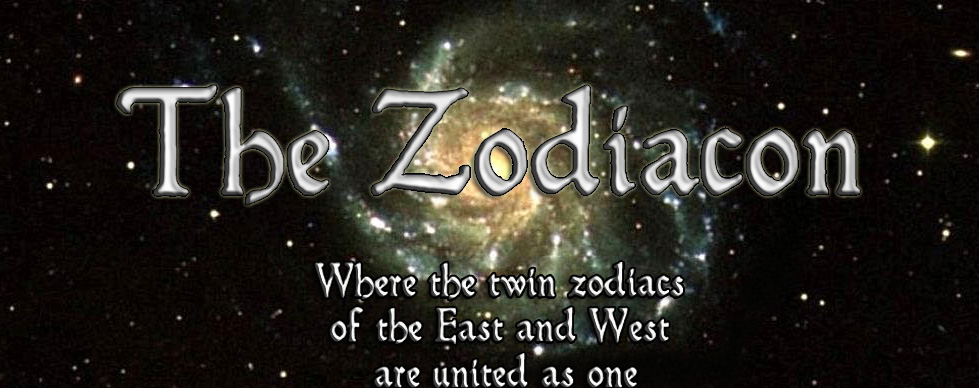




The first sign of the Eastern zodiac is the characterand is pronounced “Zi.” The symbolic animal of this first earthly stem is the rat and is represented by the character
. It is a yang symbol of the first trine, and its fixed element is water. Its assigned realm on the heavenly ecliptic consists of the portion that lies between zero point and the 30th degree. It is the lord of the eleventh lunar month, which lasts from December 7 to January 5, and the hours of the rat are from eleven in the evening to one in the morning.
The first sign of the Western zodiac is the symbolthat is commonly known as Aries. This sign is symbolic of a ram’s horns. Like its Eastern counterpart, this symbol is a positive yang symbol of the active diurnal masculine. Its elemental designation is fire and its quality is cardinal. It possesses the same coordinates of the ecliptic as does the Eastern sign of the rat, however, its yearly domain of influence is from March 21 to April 20 in the tropical system and from April 15 to May 15 in the Jyotish system.
Aries is the sign of the ram. The etymological connection between the words ram and rat cannot be denied and should be viewed as something more than coincidental. The ram depicted by this constellation is often associated with the flying ram that rescued a set of twins, a boy and a girl, whose lives were in peril from their evil stepmother. Phrixius was the male child who rode the flying ram to safety and gave the ram’s golden fleece as a present to King Aeetes, who adopted him and gave him his daughter for a bride. King Aeetes hung the golden fleece in an oak tree in a grove sacred to the god named Ares. Thus, the etymology through the ancient tales appears to favor a link of energies between the zodiac symbol of Aries and the god known as Ares. One could also link the biliteral root of the first syllable of RA with the Egyptian god of the same name, who is the god of the sun (a direct alchemical connection to gold,) and whose symbol is the eye.
Therefore if one analyses the tales from Greek folklore a little further, then it is discovered that the golden fleece of Aries was sought after by the Argonauts, whose ship was built by Argus, who was the son of Phrixius, the man who initially slaughtered the flying ram and placed its golden fleece in the sacred grove of Ares. Argonauts and Argus do bear at least a partial etymological similarity in the first syllables of their names, and the Latin word for gold is aurum. In other ancient texts, the word for ram was formed from the biliteral combination of r and m. This combination in its most basic sense has the meaning of “to rise up” or “to be high.” This meaning could be seen in the symbolism of the flying ram that is rising up high into the heavens. With the aid of this flight the ram rose up to the heights so as to rescue the twins from ensuing harm. Also, the ram is an animal that is commonly thought of as being a resident of the mountainous regions that rise up high above the plains, and it is not uncommon to see rams expressed in the artwork of numerous civilizations as being presented grandly atop a mountain crest or peak with its horns rising mightily into the heavens. In much the same way, the rat of the Eastern zodiac won the great race by climbing on the back of the ox so as to rise to a location of greater height and thus gain the crucial advantage.
Therefore, putting all of the pieces of this etymological puzzle together, one can assert that the combined symbols of the Western zodiac and the Eastern zodiac symbolize the beginnings of vision from the apex of golden energy. Contained in this combined symbol of beginning is the golden fleece of divine vision that comes from the heights of the heavenly ascension. On the other side of this reality is both the deceit that was required to gain the first position, as well as the loss of many of the privileges associated with this first position. The rat tricked the cat and used the ox to gain a decisive advantage, but lost in a bigger way by making the cat a permanent foe.
This first sign is highly prolific with etymological similarities that feature the letter Resh (R in modern English) in a very prominent fashion. Even when one uses the most popular word to describe the constellation of Aries, which is the word ram, then the similarities extend even further. First of all it would be prudent to examine the letter structure of t*he name for the letter Resh, which is the biliteral root consisting of Resh and Shem. This root possesses the basic meaning of “beginning” or “to begin.” This would perfectly fit into the overall theme and context of this first set of symbols being the first or beginning group for this system of twelve.
* * *






HOME * BOOK * SANCTUARY * ARCHIVE * BIOGRAPHY
JAZZ * SYLVAN * ELECTRONIC * SYMPHONIC * ROCK * REGGAE
Copyright 2012 by Lee Fitzsimmons